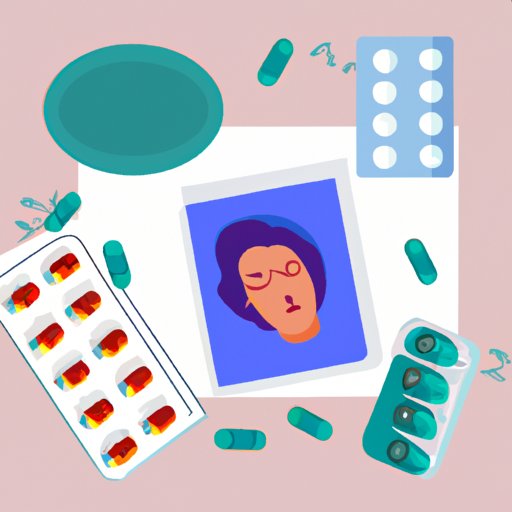
I. Introduction
Difficulty sleeping is a common experience that affects millions of people worldwide. Whether it’s struggling to fall asleep, waking up multiple times throughout the night, or waking up too early, sleep disturbances can have a significant impact on everyday life. In this article, we’ll explore the different types of insomnia, their causes, and solutions for getting a good night’s rest.
II. Insomnia: Understanding the Sleep Disorder that Affects Millions
Insomnia is a sleep disorder characterized by difficulty falling or staying asleep. Common symptoms include fatigue, difficulty concentrating, and irritability. According to the National Sleep Foundation, around 30% of adults experience short-term insomnia, while around 10% experience chronic insomnia. Insomnia can affect anyone, but it’s more common in women and older adults.
There are two main types of insomnia: acute insomnia and chronic insomnia. Acute insomnia typically lasts a few days or weeks and is often linked to a specific event, such as stress or jet lag. Chronic insomnia, on the other hand, persists for at least three weeks and is usually caused by underlying medical or psychological conditions.
III. Counting Sheep Doesn’t Always Work: Tips for Dealing with Sleeplessness
Improving sleep hygiene is one of the most effective ways to overcome sleep difficulties. Some tips for improving sleep hygiene include:
- Avoiding caffeine, nicotine, and alcohol
- Creating a consistent bedtime routine
- Making your bedroom quiet, cool, and dark
- Limiting technology use before bedtime
Relaxation techniques, such as meditation, yoga, and deep breathing exercises, can also be helpful for improving sleep. Cognitive behavioral therapy for insomnia (CBTI) is a treatment that helps individuals develop better sleep habits by addressing negative thoughts and behaviors around sleep.
IV. The Science of Sleep: Why We Struggle to Get Enough Zzz’s
Sleep is a complex biological process that is essential for our physical and mental well-being. There are two types of sleep: non-rapid eye movement (NREM) sleep and rapid eye movement (REM) sleep. NREM sleep is divided into three stages, each of which serves a different function. REM sleep is characterized by rapid eye movements and dreaming.
Our sleep is regulated by two processes: the sleep-wake homeostasis process and the circadian rhythm. Sleep-wake homeostasis is our body’s natural drive to sleep, which builds up over the course of the day. The circadian rhythm is our internal biological clock, which regulates the timing of our sleep and wakefulness.
Several factors can disrupt our sleep, such as stress, anxiety, and technology use. Blue light emitted by electronic devices can suppress the production of melatonin, a hormone that regulates sleep, making it harder to fall asleep. Noise, light, and temperature can also disrupt sleep.
V. Sleepless Nights: Causes and Solutions for a Common Problem
There are many different causes of sleeplessness, including medical conditions like sleep apnea and restless leg syndrome, mental health conditions like anxiety and depression, and medications. Understanding the underlying cause of sleep disturbances is essential for finding an effective solution.
Some solutions for addressing underlying causes of sleeplessness include:
- Seeking treatment for anxiety, depression, or other mental health conditions
- Managing symptoms of medical conditions that can affect sleep
- Talking to a doctor about adjusting medication dosages or switching to a different medication
VI. When Rest is Elusive: Coping Mechanisms for Chronic Insomnia
Coping with chronic insomnia can be challenging, but there are several strategies that can help. Some coping mechanisms for chronic insomnia include:
- Stress reduction techniques, such as progressive muscle relaxation and guided imagery
- Lifestyle changes, such as regular exercise and a healthy diet
- Limiting naps to 30 minutes or less
It’s also essential to address underlying medical and psychological conditions that can contribute to chronic insomnia. In some cases, seeking professional help from a sleep specialist or therapist may be necessary.
VII. The Truth About Sleeping Pills: Are They Worth the Risk?
Sleeping pills can be effective for short-term treatment of insomnia, but they come with risks. Common side effects of sleeping pills include dizziness, nausea, and daytime drowsiness. Long-term use of sleeping pills can also lead to dependence and withdrawal symptoms. Some natural remedies and behavioral changes, such as melatonin supplements and relaxation techniques, may be just as effective and come with fewer risks.
VIII. Conclusion
Sleeplessness is a common problem that can have a significant impact on physical and mental health. Understanding the different types of insomnia, their causes, and solutions is essential for finding effective ways to cope with sleep disturbances. Improving sleep hygiene, trying relaxation techniques, and, if needed, seeking professional help can all be effective strategies for getting a good night’s rest.
If you’re struggling with chronic insomnia, it’s important to remember that you’re not alone, and there are many solutions available. Don’t hesitate to reach out to a healthcare professional who can help you find the best treatment for your individual needs.




